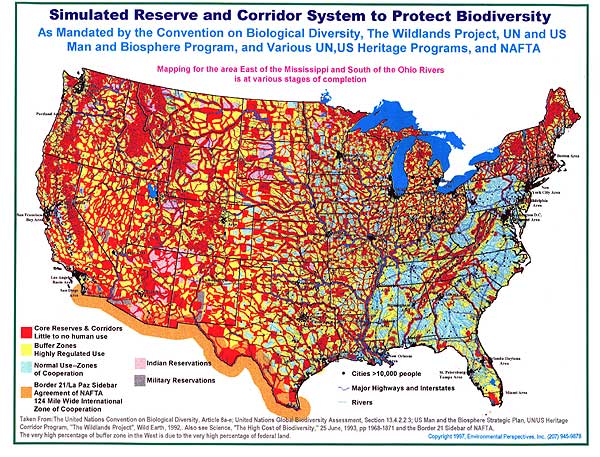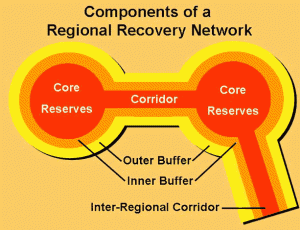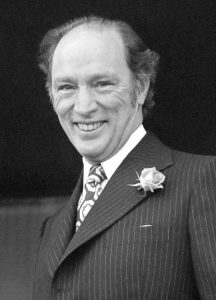Agenda 21 Wildlands Project: What you need to know
by Dr. Michael Coffman, Ph.D., September 18, 2014

[EDITOR’S NOTE: This article explains that the United Nations has been in a decades-long process of eroding landowner’s property rights in order to implement extreme “sustainable development” agendas, where at least half of the land area of the United States had been targeted to be transformed into an immense “eco-park” of corridors that will be cleansed of modern industry and private property with a claim that “The collective needs of non-human species must take precedence over the needs and desires of humans.”
I found a partial reprint of this article on the website rangefire.us, and I noticed that the original article is no longer online, so I am reprinting it here in full from a Wayback Machine version.
The United Nations Global Biodiversity Assessment called for placing vast areas of the U.S. into wilderness that is protected from human use, with core wilderness reserves that are interconnected by wilderness corridors, all of which would be surrounded by buffer zones managed to protect the wilderness areas. A key architect of the concept Dave Foreman has said, “Our vision is simple: we live for the day when Grizzlies in Chihuahua have an unbroken connection to Grizzlies in Alaska …”]
Rural landowners who desire to use their own property are shocked when they learn new regulations increasingly restrict them from doing almost anything. These regulations ostensibly protect endangered species, viewsheds, open space, or a host of other reasons for limiting the owners rights to use their land. Although the environment and society allegedly benefit from the regulations, it is the landowner who pays the price through lowered property values. Rarely does the property owner receive just compensation for the societal benefit―as required by the U.S. Constitution and almost every state constitution. Rather the property owner is required to pay the entire cost, even though all of society supposedly benefits.
ESSENTIAL BACKGROUND READING
Why Property Rights Matter
The Problem With The Endangered Species Act
International Domination of US Environmental Law and Private Property
The Wildlands Project
These regulations are usually developed by planners or other professionals who have no real-life experience in rural living. Because they have no real understanding of what is required to develop exploit natural resources, they establish idealistic arbitrary and capricious rules that make farming, ranching and timber growing increasingly difficult and less profitable. When some resource users find they can no longer farm, ranch or produce timber profitably they are forced to sell their property at a greatly reduced value because the same regulations devalue the land. Those who own property near an urban area face an added burden when their ad valorem taxes skyrocket due to the growing potential for development. Yet, when they try to sell their land for development they find their property value has plummeted because regulations requiring open space and other societal benefits severely limit the ability to develop the land and therefore its value.
Property owners in America have always accepted the need for regulations. Common law since the time of the Magna Charta has always allowed the government to restrict property use that would otherwise cause problems of safety, health, harm or nuisance to the community or the property owner’s neighbors. However, the imposition of regulations to provide vague benefits to society or the environment is relatively new in America. This new process is called sustainable development. With sustainable development, no longer do property owners in the United States have unalienable property rights, as penned in the Declaration of Independence and protected in the U.S. Constitution’s Bill of Rights. Instead, government imposes on property owners what are termed “usufructory rights.” Since unalienable property rights provide the foundation to liberty and wealth in America, sustainable development portends dire consequences to all Americans.
By definition, usufructory rights are the rights to use and enjoy the profits and advantages of something belonging to another, as long as the property is not damaged or altered in any way. Conceptually, it is similar to renting or leasing something within limits set by its true owner. The usufruct system of property use is derived from the Latin word ususfructus. Originally it defined Roman property interests between a master and his slave held under a usus fructus (Latin: “use and enjoyment”) bond. The Romans expanded this concept to create an estate of uses in land rather than an estate of possession. Having seized lands belonging to conquered kingdoms, the Romans considered them public lands, and rented (ususfructus) them to Roman soldiers. Thus the emperor retained the estate (possession) in the lands, but gave the occupier an estate of uses.
The growing mountain of environmental and other regulations that supposedly benefits the public good in the United States today has stripped Americans of the unalienable right to possess land. Instead, Americans increasingly have only the usufruct right to use the land and pay taxes (rent). As with the Romans, the government retains the right to determine how the land is used.
THE LINK BETWEEN SUSTAINABLE DEVELOPMENT AND THE WILDLANDS PROJECT
The usufruct principles of sustainable development first became public at the 1976 United Nations Conference on Human Settlements (Habitat I) held in Vancouver. For instance, the Preamble of Agenda Item 10 of the Conference Report states that:
Land…cannot be treated as an ordinary asset, controlled by individuals and subject to the pressures and inefficiencies of the market. Private land ownership is also a principal instrument of accumulation and concentration of wealth and therefore contributes to social injustice; if unchecked, it may become a major obstacle in the planning and implementation of development schemes. The provision of decent dwellings and healthy conditions for the people can only be achieved if land is used in the interests of society as a whole. Public control of land use is therefore indispensable.…” (Emphasis added)
Throughout this UN document the socialist model for private property rights are set forth as the basis for future United Nations policy:
Public ownership or effective control of land in the public interest is the single most important means of…achieving a more equitable distribution of the benefits of development…. Governments must maintain full jurisdiction and exercise complete sovereignty over such land…. Change in the use of land…should be subject to public control and regulation…of the common good. (Emphasis added)
State control over private property has been central to every international treaty since the 1970s. The United Nations’ World Commission on Sustainable Development — formalized this into international policy when it published its report Our Common Future in 1987. This landmark report helped trigger a wide range of actions, including the UN “Earth Summits” — in 1992 and 2002, the International Climate Change Convention, The Convention on Biological Diversity and worldwide “Agenda 21″ programs. Agenda 21 is a 40 chapter master plan to reorganize national laws to the socialist principles of central control. The United States signed Agenda 21 during the 1992 Earth Summit at Rio de Janeiro in 1992. Chapter 15.3 requires “urgent and decisive action” be taken “to conserve and maintain genes, species and ecosystems, with a view to the sustainable management and use of biological resources.” To do this chapter 15.4 requires that “Governments…should:
(a) Press for the early entry into force of the Convention on Biological Diversity, with the widest possible participation; and
(b) Develop national strategies for the conservation of biological diversity and the sustainable use of biological resources.
Chapter 15.5 of Agenda 21 continues by stating that “conservation of ecosystems and natural habitats…should include the reinforcement of terrestrial… protected area systems…and promot[ion of] environmentally sound and sustainable development in areas adjacent to protected areas with a view to furthering protection of these areas.” The United Nations and its international allies designed the Convention on Biological Diversity to be the workhorse in fulfilling these requirements. The treaty was merely a 18 page outline of what needed to be done. Senator Jesse Helms (R-NC) correctly called it “a preamble falsely described as a treaty.” The implementing language was to be added after enough nations ratified it to put it into force. Even so, Article 8 of the treaty uses almost identical language used in Agenda 21:
(a) Promote a system of protected areas or areas where special measures need to be taken to conserve biological diversity;
(e) Promote environmentally sound and sustainable development in areas adjacent to protected areas with a view to furthering protection of these areas.”
By August of 1993 the Clinton administration accepted Agenda 21’s challenge when it directed “natural resource and environmental agencies…develop a joint strategy to help the United States fulfill its existing international obligations (e.g. Convention on Biological Diversity, Agenda 21)…the executive branch should direct federal agencies to evaluate national policies…in light of international policies and obligations, and to amend national policies to achieve international objectives.” This effort became the primary reason for the need for vice president Gore and president Clinton to reinvent government.
To accomplish this, president Clinton also created the President’s Council on Sustainable Development. The council was comprised of green-oriented industrial leaders, natural resource cabinet heads and leaders of major environmental groups. The council produced a host of socialist guidelines to implement Agenda 21 in a series of documents under the banner of Sustainable America from 1996 to 1999. These became the official policies of the federal government and were heavily promoted by environmental non-governmental organizations (NGOs) and foundations. All are centered on the usufruct concept of property.
The United Nations intended that the implementing language for the Biodiversity Treaty be taken from the Global Biodiversity Assessment (GBA), a 1040 page tome that ostensibly scientifically defined the reason and the methodology for protecting biodiversity. The GBA establishes the need for the usufruct concept:
— Property rights are not absolute and unchanging, but rather a complex, dynamic and shifting relationship between two or more parties, over space or time. Section 11.2.3.1.2.
— One option for ensuring against excessive species depletion is the allocation of property rights in order to create markets. Section 12.7.5
— A common characteristic of many ecosystems is that resources are non‑exclusive in their use: they are in the nature of local public goods. Property rights can still be allocated to the environmental public good, but in this case they should be restricted to usufructual or user rights. Harvesting quota, emissions permits and the development rights are examples of such rights. Section 12.7.5
— “The point here is that the reallocation of property rights implies the redistribution of assets.” section 12.7.5 (Italics added)
The usufruct concept of property had to be in place before any part of Agenda 21 and the Biodiversity Treaty could be implemented. Perhaps the most chilling, however, is that in order to protect biodiversity, the GBA called for placing vast areas into wilderness and protected from human use:

Put this map into your GPS, it will tell where you soon cannot go. The UN’s manifestation of forcing people into stack and pack cities.
Representative areas of all major ecosystems in a region need to be reserved.… Reserved “blocks should be as large as possible.… Buffer zones should be established around core areas and corridors should connect these areas. This basic design is central to the Wildlands Project in the United States (Noss, 1992), a controversial…strategy…to expand natural habitats and corridors to cover as much as 30% of the US land area.” (Section 13.4.2.2.3)
In other words, the Wildlands Project was designed to be the cornerstone of the Convention on Biological Diversity. Although the ratification of the Convention on Biological Diversity was stopped in the U.S. Senate in 1994 (explained below), millions of dollars are spent annually to implement it without benefit of the treaty. It has already destroyed the lives of thousands of people. Eventually, every American will experience its severe consequences.
THE WILDLANDS PROJECT
The reference to Noss, 1992, in the GBA is to a special issue of Wild Earth, a publication of the Cenozoic Society, a NGO committed to re-wilding the United States. In this issue, Dr. Reed Noss lays out in detail the land conservation strategy to implement the Wildlands Project. (1) The Wildlands Strategy calls for establishing core wilderness reserves that are interconnected by wilderness corridors, all of which would be surrounded by buffer zones managed to protect the wilderness areas (See Figure 1).
The Wildlands Project calls for establishing thousands of core reserves and interconnecting corridors from Alaska and the Northwest Territories to Chile and Argentina.
The strategy normally is accomplished in five steps:

1. Identify existing protected areas such as federal and state wilderness areas, parks, national monuments, refuges and other designated sites. They should be from 100,000 to 25 million acres in size. These are already wilderness or close to it. Such tracts would serve as “core reserves” completely off-limits to human activity.
2. Identify other multiple-use government land that can be politically forced into wilderness status. Roadless areas are highest priority, but existing roads can be closed if roadless areas are not available.
3. Create wilderness corridors along streams, rivers and mountain ranges that interconnect the core reserves.
4. Purchase, condemn or regulate private property to fill in the gaps where public land did not exist. Usufruct regulation is preferred because the government would not have to pay for the land.
5. Create buffer areas around land not in core reserves or interconnecting wilderness to manage them sustainably so they protect the core wilderness areas.
Wildlands Project co-author Reed Noss explains that in the core, corridor and buffer areas, “The collective needs of non-human species must take precedence over the needs and desires of humans.” (1) The Wildlands Project (now Wildlands Network) is the master plan for both Agenda 21 and the Biodiversity Treaty, and represents a grandiose design to transform at least half the land area of the continental United States into an immense “eco-park” cleansed of modern industry and private property. Says Noss:
One half of the land area of the 48 conterminous [United] States be encompassed in core [wilderness] reserves and inner corridor zones (essentially extensions of core reserves) within the next few decades.… Half of a region in wilderness is a reasonable guess of what it will take to restore viable populations of large carnivores and natural disturbance regimes, assuming that most of the other 50 percent is managed intelligently as buffer zone… Eventually, a wilderness network would dominate a region and thus would itself constitute the matrix, with human habitations being the islands. (2)
The Wildlands concept is largely the work of Dave Foreman, the principal founder of the eco-terrorist group Earth First! and a former member of the board of the Sierra Club. Foreman describes the Wildlands Project as an effort to “tie the North American continent into a single Biodiversity Preserve.” Foreman summarizes Wildlands as “a bold attempt to grope our way back to 1492” — that is, to repeal a half-millennium of Western civilization, with its unique blessings of material prosperity, technological progress, private property and individual rights. Indeed, the vision statement of the Wildlands Project is stunning in scope;
Our vision is simple: we live for the day when Grizzlies in Chihuahua have an unbroken connection to Grizzlies in Alaska; when Gray Wolf populations are continues from New Mexico to Greenland; when vast unbroken forests and flowing plains again thrive and support pre-Columbian populations of plants and animals; when humans dwell with respect, harmony, and affection for the land… (3)
John Davis, editor of Wild Earth, acknowledges that the Wildlands Project seeks nothing less than “the end of industrial civilization.… Everything civilized must go…“ (4)
In this bizarre scheme, human civilization must be radically reconfigured, mines would be closed, roads torn from the landscape, timber harvesting stopped and human populations relocated. All of this is to be done, according to Wildlands co-founder Michael Soulé, in harmony with a prophetic vision: “The oracles are the fishes of the river, the fishers of the forest and articulate toads. Our naturalists and conservation biologists can help us translate their utterances. Our spokespersons, fund-raisers and grass-roots organizers will show us how to implement their sage advice.” (5)
DEFEATING THE BIODIVERSITY TREATY
All of this could be dismissed as flatly ridiculous were it not for its central role in the UN Convention on Biological Diversity and its near religious support by nearly all of the environmental NGOs. Agenda 21 and the Biodiversity Treaty would permit a restructured and unaccountable UN Trusteeship Council to regulate any human activity that presents potential harm to biological diversity. Secretary General Kofi Annan’s July 18, 1997 UN Reform plans, “[the Trusteeship Council will] be reconstituted as the forum through which Member states exercise their collective trusteeship for the integrity of the global environment and common areas.… At the same time, it should serve to link the United Nations and civil society in addressing these areas of global concern. “6 In principle, this mandate would cover all human activity, given that almost anything humans do is deemed as harmful to biological diversity.
THE BIODIVERSITY TREATY WOULD PERMIT A RESTRUCTURED AND UNACCOUNTABLE UN TRUSTEESHIP COUNCIL TO REGULATE ANY HUMAN ACTIVITY THAT PRESENTS POTENTIAL HARM TO BIOLOGICAL DIVERSITY
The Senate was asked to authorize the creation of implementing “protocols” that would be written after the treaty had been ratified and would be binding upon the signatories. The “factual” information upon which the implementing language was to be based was found in a 1,140-page UN Global Biodiversity Assessment (GBA) that was in draft form when the Senate was considering the treaty.
The Senate was poised to ratify the Biodiversity Treaty in September 1994, when the American sheep industry obtained a portion of the draft GBA from the International Union for the Conservation of Nature (IUCN) in Switzerland, the original author of the treaty. As noted above, the GBA specifically cites the Wildlands Project as the template for protecting biodiversity. It was the smoking gun.
The draft GBA, along with maps provided by Environmental Perspectives, Inc. depicting what this would look like when fully implemented, arrived the day of the vote and was taken to the Senate floor by Senator Kay Bailey Hutchinson (R-TX) a mere hour before the scheduled cloture vote for the treaty. The extremely controversial UN information caused then-Senate Majority Leader George Mitchell (D-ME) to withdraw the treaty from consideration. It was never voted on.
The connection between the Biodiversity Treaty and the Wildlands Project was not a coincidence. The treaty was originally written by the IUCN in 1982, about the time it was promoting a new science called conservation biology, which, in turn, provided the justification for the Biodiversity Treaty. Two of the key promoters of this unproven science were none other than Reed Noss and Michael Soulé who, along with Dave Foreman, co-authored the Wildlands Project. Although few Americans have even heard of the IUCN, this organization has its fingerprints on just about every alleged environmental problem in America today. Read the International Domination of US Environmental Law and Private Property for more information on this connection.
- Reed Noss. “The Wildlands Project, Land Conservation Strategy.” Wild Earth, Special Issue, 1992, pp. 10–25.
- Ibid, p. 15.
- Dave Foreman, et. al. “The Wildlands Project, Land Conservation Strategy.” Wild Earth, Special Issue, 1992, pp. 3.
- John Davis. “The Wildlands Project, Land Conservation Strategy.” Wild Earth, Special Issue, 1992, pp.9.
- Michael Soulé. “The Wildlands Project, Land Conservation Strategy.” Wild Earth, Special Issue, 1992, pp.9.
- Documents ‘Track I’ (A/51/829) of March 17th, 1997, and ‘Track II’ (A/51/950) of July 14th, 1997.





